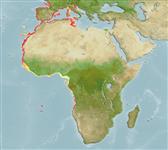>
Pleuronectiformes (Flatfishes) >
Soleidae (Soles)
Etymology: Solea: Latin, solea = sandal (shoe); refered to the flat shape of the fish (Ref. 45335).
More on author: Kaup.
Environment: milieu / climate zone / depth range / distribution range
Ekologi
laut dasar (demersal); kisaran kedalaman 12 - 100 m (Ref. 5304). Tropical; 47°N - 16°S, 19°W - 14°E
Eastern Atlantic: Mainly Central Atlantic (from France to Angola). Western Mediterranean: Herculean migrant (entered the Mediterranean via Gibraltar) (Ref. 43448).
Size / Weight / umur
Maturity: Lm ? range ? - ? cm
Max length : 60.0 cm SL jantan/; (Ref. 5304); common length : 45.0 cm TL jantan/; (Ref. 26999)
deskripsi pendek
Kunci identifiaksi (pengenalan) | Morfologi | Morfometrik
Duri punggung (Keseluruhan (total)) : 0; duri punggung lunak (Keseluruhan (total)) : 72 - 95; Duri dubur: 0; Sirip dubur lunak: 60 - 75; vertebrata, bertulang belakang: 44 - 46. Last ray of dorsal and anal fins joined by a low membrane to the base of the caudal fin. Supratemporal branch of lateral line forming an arch. Anterior nostril on the blind side not enlarged, its diameter about half that of the eye; it is situated rather close to the front margin of head, the distance slightly greater than that separating the nostril from the mouth cleft, 1:1-1.4. Length of scales above nasal tube on ocular side much less than the length of the tube. Gill rakers like short knobs on first gill arch on ocular side. Pectoral fin on the ocular side with a black botch over the whole middle and distal part of the fin; blind side whitish (Ref. 32649).
Flatfish with oval and asymmetric body (eyes on the right side). Interradial membrane on the pectoral fin on the eye
side is of black colour(A). This feature distinguishes it from common sole (Solea soled), which has a big black compact spot on the posterior side of this fin. In the Atlantic, from the Gulf of Biscay to the coasts of Senegal. Less frequent in the Western Meditarranean.
A predominantly littoral species. Benthonic marine species living in sandy or muddy bottoms, off coastal areas up to
100 m depth and in brackish lakes.Feeds basically on benthonic invertebrate, such as larvae from polychaets and
bivalve molluscs. Also on small crustaceans.Sexual maturity is reached when size is 30 cm. Spawning happens beween the months of March until June. Maximum depth reported taken from Ref. 127989.
Life cycle and mating behavior
Kematangan | Reproduksi, perkembang biakan | Pemijahan | telur-telur | Fecundity | Larva
Desoutter, M., 1990. Soleidae. p. 1037-1049. In J.C. Quero, J.C. Hureau, C. Karrer, A. Post and L. Saldanha (eds.) Check-list of the fishes of the eastern tropical Atlantic (CLOFETA). JNICT, Lisbon; SEI, Paris; and UNESCO, Paris. Vol. 2. (Ref. 5304)
Status IUCN Red List (Ref. 130435: Version 2024-1)
ancaman kepada manusia
Harmless
penggunaan manusia
Perikanan: komersial; Budidaya air: percobaan
Alat, peralatan
laporan khas
muat turun XML
Sumber internet
Estimates based on models
Preferred temperature (Ref.
123201): 13.6 - 21.6, mean 18.6 °C (based on 46 cells).
Phylogenetic diversity index (Ref.
82804): PD
50 = 0.5020 [Uniqueness, from 0.5 = low to 2.0 = high].
Bayesian length-weight: a=0.00813 (0.00541 - 0.01222), b=3.06 (2.94 - 3.18), in cm total length, based on LWR estimates for this species & Genus-body shape (Ref.
93245).
Trophic level (Ref.
69278): 3.3 ±0.45 se; based on food items.
Generation time: 6.2 ( na - na) years. Estimated as median ln(3)/K based on 2
growth studies.
Daya lenting (Ref.
120179): sedang, Waktu penggandaan populasi minimum 1.4 - 4.4 tahun (Preliminary K or Fecundity.).
Fishing Vulnerability (Ref.
59153): Moderate to high vulnerability (49 of 100).
Climate Vulnerability (Ref.
125649): Moderate vulnerability (43 of 100).
Nutrients (Ref.
124155): Calcium = 125 [47, 316] mg/100g; Iron = 0.902 [0.386, 1.792] mg/100g; Protein = 17.3 [15.4, 19.2] %; Omega3 = 0.124 [0.066, 0.233] g/100g; Selenium = 29.6 [10.7, 97.8] μg/100g; VitaminA = 11.9 [3.4, 40.5] μg/100g; Zinc = 0.654 [0.349, 1.413] mg/100g (wet weight); based on
nutrient studies.
